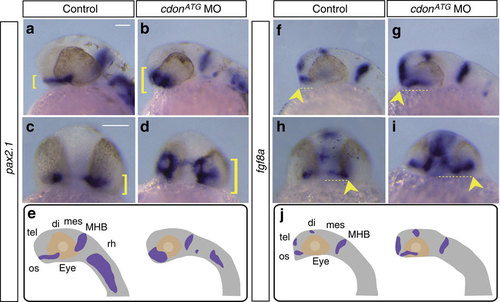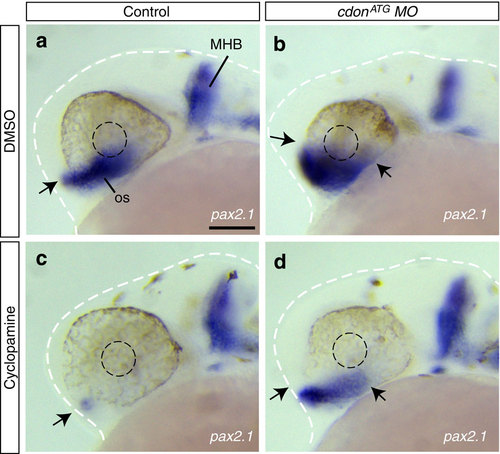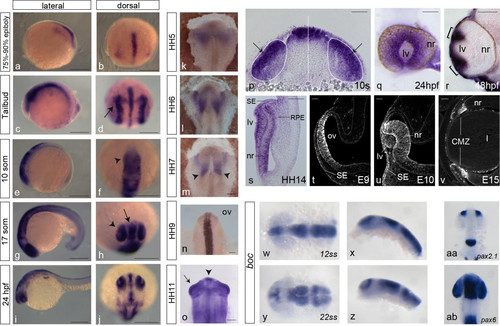- Title
-
Cdon acts as a Hedgehog decoy receptor during proximal-distal patterning of the optic vesicle
- Authors
- Cardozo, M.J., Sánchez-Arrones, L., Sandonis, A., Sánchez-Camacho, C., Gestri, G., Wilson, S.W., Guerrero, I., Bovolenta, P.
- Source
- Full text @ Nat. Commun.
|
(a–c) Ventral views of anterior zebrafish forebrain at optic vesicle (a is ventral to b) and optic cup (d, e) stages immunostained in toto with antibodies against Pax2 and Shh. (f–i) Dorsal (f,h) and lateral (g,i) views of zebrafish embryos hybridized in toto with probes specific for ptc1 and cdon at the 20 somites’ stage (20 ss). (j–k) Coronal sections of embryos (75–90% epiboly) hybridized for cdon and shh. The white arrows in b,c and e point to Shh immunolabelling in Pax2-positive cells. Dashed lines in a–d,j and k indicate the embryonic midline. Continuous white and black lines in f–i outline the lens and the embryonic border, respectively. a, anterior; d, dorsal; os, optic stalk; ov, optic vesicle; p, posterior; v, ventral. Scale bar, 25 μm. EXPRESSION / LABELING:
|
|
(a–j) In situ hybridization analysis for two optic stalk markers, pax2.1 (a–d) and fgf8a (f–i) at 28 hpf and 24 hpf, respectively. Embryos are shown in lateral (a,b,f,g) and frontal (c,d,h,i) views. Expression patterns of both genes are schematically represented in e and j. In cdonATG morphants, pax2.1 expression is expanded dorsally in the optic stalk (b,d brackets) when compared with controls (a,c brackets). Fgf8a expression is expanded caudally and laterally in the optic stalk (g,i arrowhead and dotted lines) as well as in the telencephalon (g,i) when compared with control embryos (f,h arrowhead and dotted lines). di, diencephalon; mes, mesencephalon; MHB, midbrain–hindbrain boundary; os, optic stalk; rh, rhombencephalon; tel, telencephalon. Scale bars, 100 μm. EXPRESSION / LABELING:
|
|
(a–d) Lateral views of control or cdonATG morphants treated with DMSO (vehicle) or cyclopamine from 90% epiboly and analysed with ISH for pax2.1 expression at 28 hpf. Blocking Hh signalling abolished pax2.1 expression in the optic stalk in wt embryos (c). In cdonATG morphants, cyclopamine treatment counteracts the expansion of pax2.1 overexpression observed in cdonATGMO injected embryos (a,b,d). The lens and the body are outlined with black and white dashed lines in (a–d). Arrows indicate the extent of the pax2.1 expression in the optic stalk. DMSO, dimethyl sulphoxide; MHB, midbrain–hindbrain boundary; oc, optic cup; os, optic stalk. Scale bar, 100 μm. EXPRESSION / LABELING:
|
|
(a) Schematic diagram of the design of the exon skipping MO used in the study. (b) Schema representing the zebrafish cdon mRNA (zcdon) aligned with the corresponding Cdon protein indicating the domains targeted by cdonspl8, cdonspl11a, cdonspl11d and cdonspl14 MOs. The exons that encode the 52 and 32 UTR regions are depicted in blue; those that, when skipped, generate a translational frame shift are indicated in red; whereas those that, when skipped, maintain the reading frame are indicated in green. (c,f,i) RT–PCR analysis of the exon skipping function of cdonspl8, cdonspl14 and cdonspl11a/cdonspl11d MOs. For detailed information about the resulting bands, noted 1–9, please refer to Supplementary Fig. 8. (d,e,g,h,j,k) ISH analysis of pax2.1 expression pattern in cdonspl8 (d,e), cdonspl14(g,h) and cdonspl11a/cdonspl11d (j,k) MO injected embryos at 26–28 h.p.f. Pax2.1 expression domain is expanded in cdonspl8 (d,e) and cdonspl14 morphants (g,h) in comparison with their respective controls, whereas there was no difference in the pax2.1 expression domain of control and cdonspl11a/cdonspl11d morphants (j,k). (l) Quantification of the optic stalk pax2.1-positive expression domain in embryos injected with the different MOs at 26–28 h.p.f. (***P< 0.001; Student’s t-test). The number of embryos analysed in each case is indicated in each column and are as follows: CdonATG MO injection (control, n=28; MO, n=45); Cdonspl8 MO injection (control, n=12; MO, n=44); Cdonspl11a and Cdonspl11d MOs injection (control, n=26; MO, n=65); Cdonspl14 MO injection (control, n=22; MO, n=57). Error bars represent s.e.m. Scale bars, 100 μm. MWM, molecular weight marker. EXPRESSION / LABELING:
|
|
Cdon expression in vertebrate embryos. Lateral (a-i) and dorsal (b-j) views of zebrafish and ventral (k-m) and dorsal (n, o) views of chick embryos at different developmental stages hybridized in toto with a Cdon specific probe and immunohistochemistry of Cdon distribution in the developing mouse embryonic eye (t-v). The zebrafish distribution of boc (w-z), pax2.1 (aa) and pax6 (ab) is shown for comparison with embryos hybridized in toto with probes specific for cdon at different stages of development. Images in (p, r) are coronal cryostat sections of zebrafish embryos hybridized in toto. In zebrafish at 75-90% epiboly cdon transcripts are detected in the ventral midline (a, b). At tailbud stage cdon mRNA localizes to the presumptive neural crest (c, d arrow) and at 10-17 somite stages in the optic vesicles (f, h arrowhead), prechordal plate, telencephalon (h, arrow) and dorsal neural tube (e-h). At 24 hpf cdon expression becomes restricted to the retina and the dorsal neural tube (i, j). In chick embryos, Cdon expression is first detected at the Hensen´s node (k), and later in the presumptive neural crest (l-n), somites (m arrowheads) and CNS (n). At HH11 Cdon mRNA localizes to the optic vesicles and dorsal CNS (o, arrow and arrowhead respectively). Cdon expression is restricted to regions of the telencephalon and the presumptive retinal domain of the optic vesicle at 10ss stage (p) to finally restricting to the ciliary margin zone (CMZ) (see brackets in q, r). Cdon expression in the developing eye is conserved in chick (s) and mouse embryos (t-v). Note that boc is not expressed in the optic vesicle (w, x) or the optic cup (y, z). The white dashed lines in p indicate the midline and the optic vesicles. The white dashed line in t-v delineates the neural epithelium. CMZ, ciliary marginal zone; l, lens; lv, lens vesicle; nr, neural retina; ov, optic vesicle; RPE, retinal pigmented epithelium; SE, surface ectoderm. Scale bars: 200 μm.EXPRESSION / LABELING:
|
|
cdonATG MO efficiently interferes with cdon expression inducing morphants that present defects in the ventral region of the eye. a) Schematic diagram of the strategy used to test the specificity of an antisense morpholino (MO) designed against the translation start site sequence of cdon (cdonATG). This MO or a standard control MO (MOct) were co-injected into medaka fish embryos with the cRNA of a reporter construct (5′cdon-GFP) carrying the zebrafish cdon 5′ sequence upstream of the gfp sequence. Translation of this construct (evident by expression of GFP) was efficiently knocked down by cdonATG MO (c) (25/25 embryos) but not by the MOct (b) (20/20 embryos). None of the two MO interfered with the translation of the GFP alone (d, e) (23/23 embryos). Bright field lateral (f-i) views of embryos injected with MOct (f, g) or cdonATG MO (h, i). cdonATG MO (h, i) but not MOct (f, g) injected embryos are characterized by alteration of the ventral retina (vr) at 28 hpf. The asterisks indicate the optic fissure in cdonATG morphant (i), which remains open at 36 hpf (compare insets in g, i). l, lens; vr, ventral retina. Scale bars: 40 μm (b-e). Scale bars: 100 μm (f-i). PHENOTYPE:
|
|
cdonspl8 splicing MO reproduces the phenotype observed in cdonATG morphants, which display an expansion of ventral markers. Bright field, lateral images of 48 hpf control (a) and cdonspl8 morphant characterized by the presence of coloboma (b). Lateral views of the eyes of control and cdonspl8 morphants hybridized in toto with probes for pax2.1 (c, d) (17/40 embryos). Note that in cdonspl8 morphants pax2.1 expression is expanded in comparison to controls (c, d). Lateral views of the eyes of control and cdonATG morphants hybridized in toto with probes for the ventral retinal markers pdzrn3 (e, f) and rdh10a (g, h) or the dorsal retinal marker tbx5.1 (i, j). In cdonATG morphants the ventral retina markers pdzrn3 (28/54 embryos) and rdh10a (32/44 embryos) are also expanded in comparison to controls (e-h) whereas tbx5.1 (62/62 embryos) shows no evident changes in comparison to controls (i, j). The dashed lines mark the lens, and the asterisks indicate the position of the optic fissure. (k-n) Horizontal cryostat sections of control and cdonATG morphant embryos hybridized with probes for nkx2.1 and nkx2.2 at 26hpf. The dotted black lines indicate the distance from the midline to the optic cup. The yellow lines depict the extent of gene expression in the medio-lateral direction and the yellow arrowheads indicate the most distal/lateral position of the positive signal. The dotted yellow line in n depicts the expansion of nkx2.2 expression observed in cdonATG embryos. o) Quantitative analysis of the nkx2.1 and nkx2.2 anterior expression domains. Note that nkx2.2 expression in morphants is significantly different from that of controls (**p< 0.01; Student’s t-test). The number of embryos analysed in each case is as follow: nkx2.1, n=8 for both control and MO injected embryos; nkx2.2, n=10 for both control and MO injected embryos). This information is also indicated in each column Error bars in o represent s.e.m. a, anterior; d, dorsal; lv, lens vesicle; oc, optic cup; p, posterior; v, ventral. Scale bars: 100 μm. |
|
Overexpression of Cdon or CdonΔFnIII(2) in the eye rescues the optic stalk phenotype of cdon morphants. a) The schema depicts the injection method used in rescue experiments. Embryos expressing Gal4 protein in the rx3 positive domain (rx3::Gal4) were injected at 1-cell stage into the cell with UAS::GFP, UAS::Cdon, UAS::CdonΔFnIII(2) or UAS::CdonΔFnIII(3) DNA. After DNA injection, the eggs were injected with CdonATG MO into the yolk and the embryos were let develop until 26hpf (b). c) GFP expression was detected in the retinal and hypothalamic domains of the injected embryos. α-HA immunostaining in rx3::Gal4 embryos injected with UAS::Cdon DNA confirmed localized expression of Cdon in the retina of injected embryos (d, e). Note the membrane localization of the HA-signal (red arrows in e. f) Quantification of optic stalk pax2.1-positive domain in embryos co-injected with different UAS DNAs and cdonATG MO at 26-28hpf (*p<0.05, **p<0.01; Student’s t-test). The number of embryos analysed in each case is indicated in each column and are as follow: control/UAS::GFP, n=8; CdonATG MO/UAS::GFP, n=9; control/UAS::Cdon, n=12; CdonATG MO/UAS::Cdon, n=20; control/UAS::CdonΔFnIII(2), n=13; CdonATG MO/UAS::CdonΔFnIII(2), n=17; control/UAS::CdonΔFnIII(3), n=10; CdonATG MO/UAS::CdonΔFnIII(3), n=17. Error bars represent s.e.m. Note that the expansion of the pax2.1-positive optic stalk domain generated by cdonATG MO injection was less evident than that reported in Fig. 4l, likely owning to MO injection at two-four cells’ stage (see Methods). Scale bar: 100 μm. |








